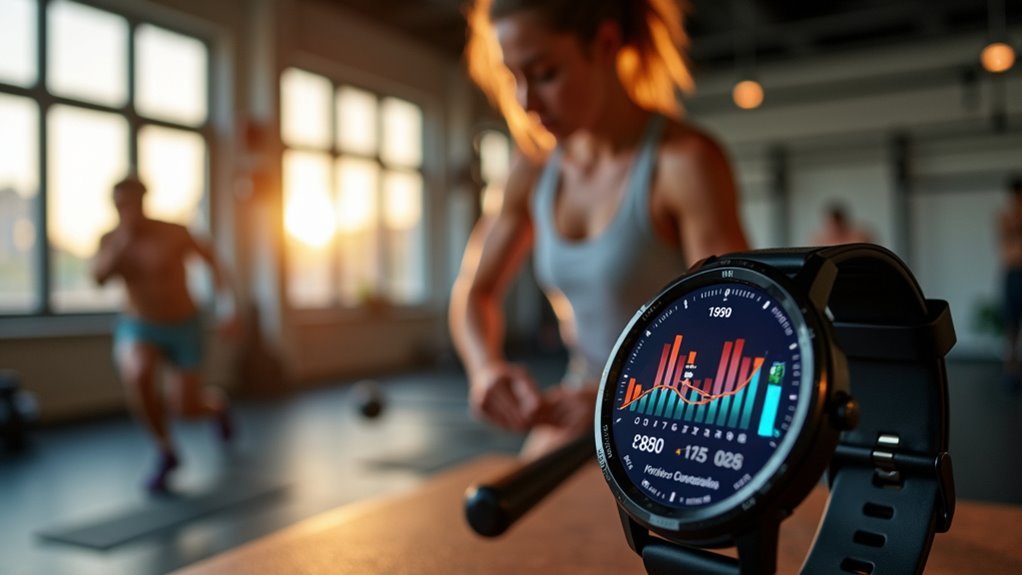You’ll master training effect scores by first understanding the 0.0-5.0 scale where anything below 1.0 won’t improve fitness. Second, combine heart rate data with EPOC measurements to gauge workout intensity accurately. Third, monitor physiological responses like blood lactate and heart rate variability between sessions. Fourth, integrate Training Stress Scores with your training effect data to prevent overtraining. Fifth, apply progressive overload principles while tracking cumulative stress patterns. These strategies will reveal deeper insights into your fitness adaptations.
Decoding the 0.0 to 5.0 Training Effect Scale

When you see a Training Effect score on your fitness device, you’re looking at a 0.0 to 5.0 measurement that quantifies how much your latest workout stressed your body’s systems.
Each range tells a different story about your session’s impact. Scores from 0.0-0.9 mean you didn’t stress your body enough to trigger adaptations.
The 1.0-1.9 range indicates light recovery work that promotes regeneration. You’ll maintain current fitness levels with 2.0-2.9 scores, while 3.0-3.9 actually improves your conditioning.
Highly improving sessions score 4.0-4.9, demanding serious recovery time. A perfect 5.0 represents maximum stress that disrupts your body’s balance—you shouldn’t hit this regularly unless it’s race day or a specialized overreaching session. Your maximum heart rate settings must be accurate for these scores to reflect your true training impact.
Using Heart Rate Data and EPOC for Accurate Measurements
Understanding Training Effect scores requires diving deeper into the physiological data that powers these calculations. Your heart rate provides real-time intensity feedback and shows cardiovascular strain during workouts.
When you can maintain the same pace at a lower heart rate, you’re seeing fitness improvements.
EPOC measures your elevated oxygen consumption after exercise, indicating greater metabolic impact and training stimulus. Higher EPOC values mean more calories burned and stronger workout effects.
Combining both metrics gives you complete training load insights. Your heart rate shows internal stress while EPOC reveals post-exercise metabolic demands. These measurements help you maintain desired effort levels during your training sessions without constantly guessing your intensity.
Devices like Garmin use these inputs to generate accurate Training Effect scores, helping you avoid overtraining while targeting specific fitness gains through personalized intensity zones.
Analyzing Physiological Responses to Optimize Workout Impact

Your physiological responses tell a more complete story than heart rate alone, revealing how your body adapts at the cellular and neurological levels during exercise.
Blood lactate levels indicate when you’re pushing into higher intensity zones, while heart rate variability shows how well you’re recovering between sessions. Advanced wearables like Tyme Wear now track ventilation patterns, giving you precise intensity targeting beyond basic heart rate monitoring.
Your brain-derived neurotrophic factor levels change with exercise intensity, affecting neuroplasticity and cognitive function. You can assess this through tools like the Stroop test, which measures executive function recovery. Different rest intervals between exercises significantly alter your metabolic stress responses, with continuous protocols creating greater physiological demands than structured recovery periods.
Integrating Training Stress Scores With Training Effect Data
While physiological markers reveal how your body responds to exercise, Training Stress Scores (TSS) quantify the actual workload you’re placing on your systems during each session.
By combining TSS with training effect data, you’ll gain a thorough understanding of both workout stress and your body’s physiological response. This integration helps you maintain ideal balance between training intensity and recovery.
You can prevent overtraining by monitoring when your TSS accumulates faster than your body adapts. Advanced tools automatically adjust your training plans based on these combined metrics, ensuring continuous progress without overexertion. Different training disciplines require sport-specific calculations, with running using rTSS based on pace data and swimming using sTSS derived from threshold swim pace.
The result is personalized feedback that considers muscle soreness, fatigue levels, and cumulative stress. This approach enhances long-term training sustainability while preventing burnout and maximizing performance gains.
Applying Best Practices for Long-Term Fitness Progression

Armed with extensive data from training stress scores and physiological responses, you can now implement proven strategies that sustain momentum over months and years.
Apply progressive overload by increasing workout intensity, volume, or frequency gradually—never exceeding 10% weekly increases for cardio training. Set SMART goals that create measurable milestones and conduct regular fitness assessments to identify improvement areas.
Track your workouts consistently through logs or apps to maintain motivation and assess effectiveness. Incorporate workout variety to prevent stagnation while ensuring adequate nutrition and recovery support your training adaptations.
Build support systems through workout partners or coaches for enhanced accountability. Balance heavy lifting sessions with submaximal training at 65-85% of your one-rep max to promote better recovery and adaptation.
Remember that long-term fitness requires patience as progress occurs incrementally. Focus on gradual progression rather than dramatic changes to prevent injury and allow proper physiological adaptation.
Frequently Asked Questions
How Do Training Effect Scores Differ Between Beginners and Advanced Athletes?
You’ll generate higher Training Effect scores as a beginner since you’re adapting faster to exercise. Advanced athletes need more intense workouts to achieve similar scores due to their higher baseline fitness levels.
Can Medications or Health Conditions Affect Training Effect Score Accuracy?
Yes, medications like beta blockers and stimulants can greatly affect your training effect scores by altering heart rate responses. Health conditions such as cardiovascular disease also impact accuracy through chronotropic incompetence.
What’s the Minimum Workout Duration Needed to Generate a Training Effect Score?
You’ll need at least 10 minutes of sustained activity to generate a training effect score. However, you can achieve meaningful aerobic benefits with sessions lasting just 10-15 minutes at appropriate intensity levels.
How Do Environmental Factors Like Altitude or Temperature Impact Training Effect Scores?
Environmental factors greatly affect your training effect scores. High altitude reduces oxygen availability, lowering your cardiovascular efficiency. Extreme temperatures increase stress on your body, potentially decreasing your scores until you’ve properly acclimatized.
Are Training Effect Scores Reliable for Non-Traditional Exercises Like Yoga or Crossfit?
Training effect scores aren’t reliable for non-traditional exercises like yoga or CrossFit. You’ll find they underestimate benefits since algorithms favor steady-state cardio over variable-intensity workouts with mixed movement patterns.
In Summary
You’ll maximize your training effectiveness by mastering these five approaches to training effect scores. Don’t just track numbers—analyze how your heart rate data, EPOC measurements, and physiological responses connect to create meaningful insights. You’re building sustainable fitness when you integrate training stress scores with effect data and follow proven progression practices. Remember, you’re not chasing perfect scores but consistent improvements that align with your body’s adaptive responses over time.





Leave a Reply